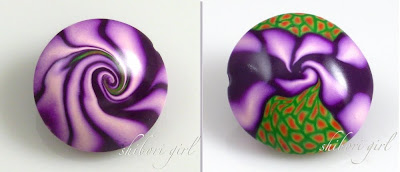My adventures into the polymer clay medium continue with pendants being my focus for the past two weeks. I've been steadily creating flower canes since Christmas, collecting them in drawers, waiting until I have enough variety to let my imagined flower garden come to life in clay.
I started with a bracelet cuff.
I cut slices from my flower and leaf canes, trimmed away excess clay packed around petals, and laid them one-by-one onto a black background. Satisfied with the arrangement, I then cobbled translucent clay between the floral elements to fill in the spaces. My hope was to minimize sanding time after baking.
Once the bracelet was baked, I recognized my fairly serious mistake right away. Air pockets were trapped in the spaces between elements, and the black clay now looks purple. As well, there were dips and valleys where the added background clay met the flowers and leaves. Much sanding later, I have a (mostly) smooth bracelet, but those pesky air pockets are still there, preserved forever in clay.
I'll be keeping this bracelet. It's a pretty thing, and I enjoy it, but the flaws are too "in my face" to ever pass it onto a customer. Next time, I'll fuse a very thin layer of translucent clay to the background and then press the flower elements into that. Hopefully that will eliminate the air pocket issue altogether.
Meanwhile, after the Great Bracelet Debacle, I needed something to go right. I explored using these same flower and leaf canes to make "window" pendants.
They came out just as I'd hoped, like little paintings.
However, I can't seem to let well enough alone - I felt my new pendants needed a little something extra special. I've planned to try a butterfly cane ever since I saw one in Donna Kato's millefiore clay book. Time to stop talking about it and just do it. It was a monster cane and took nearly 5 hours to put together. At that point, I said "you're done! No more packing clay to make you round, just stay a triangle." After reducing this behemoth, the wings were distorted because of the triangular shape, but the color gradations were pretty amazing. I was very conflicted at this point: the perfectionist in me was pissed that I'd taken a short cut and not rounded the cane. But the clayer in me looked at the finished cane and shouted "AWESOME!"

The cane was very soft, even after resting in the freezer for a few minutes and slicing distorted the butterfly slices even flatter, but when I rolled the slice flat onto the pendant, it elongated again and looks nearly perfect. I don't even mind the slight blurring at the wing tips - makes me think it looks realistically in flight.
I am so happy with these little beauties!
I hope to have these listed in a few days in my Etsy shop. Keep an eye out for them.

copyright 2010
Shibori Girl





































